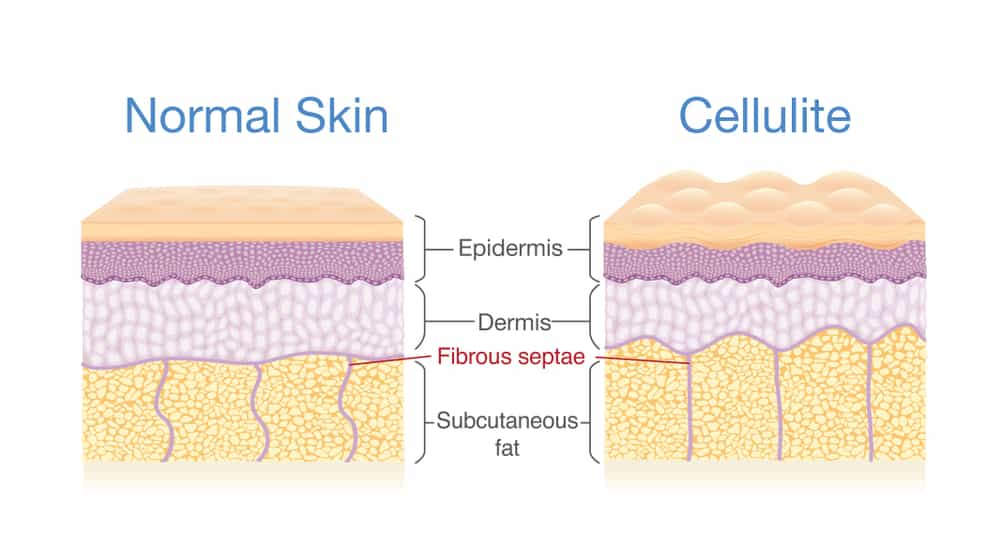Where Does Cellulite Come From?

Cellulite
Our body is so intelligent that it contains cells made specifically to store fat. These cells may expand to 60 times their capacity, providing ample storage room; but, if they do so excessively, they distort the skin's fiber network and facilitate the formation of fatty tissue. The well-known "orange-peel" look of cellulite is the padding and filling of the skin's surface.
Your thighs, hips, butt, and tummy may have that lumpy-appearing fat due to a nuisance called cellulite. Even though some of us were given it by our DNA, it might be difficult to get rid of, but there are methods to avoid it (or at least slow it down). Here are several causes of cellulite that you may not be aware of, along with some solutions.

Medical Definitions of Cellulite
The connective tissue known as the septa, which separates fat from the top layers of skin, is breached as a result of fat cells enlarging, congregating, and pushing through it.
Cellulite is categorized medically into four different groups, and which one applies depends on how severe the problem is. Let's look more closely at each level of the condition. The skin in Grade Zero is entirely smooth, with no signs of dimpling whatsoever, even when the skin is squeezed. This skin may be regarded as cellulite-free. Cellulite is present but only apparent when squeezed in Grade 1, which is the lowest rung on the scale. The following level, grade 2, is characterized by cellulite that is visible while standing but goes away when lying down.
Grade 3 is the highest degree, and it will be seen in the afflicted region whether you're laying down or standing up. It will also become more obvious when you squeeze the skin. Typically, only the buttocks and thighs are affected, but the arms and belly may also be affected. However, the majority of women lament having cellulite on the backs of their upper thighs and buttocks. Only around 10% of males get cellulite throughout their lifetimes, which is nowhere near the same frequency as it does for women.
This is mostly caused by the biological variations in where and how fat is stored in men and women. It is a little surprising that cellulite has such a stigma given the high prevalence of the illness among females. The Photoshopping of famous women in the media, where flaws like these are easily wiped off, has been cited by some as the reason why the prevalence of cellulite isn't well recognized.
What's Going on Inside, Then?
So far, we've discussed how cellulite appears on the exterior and briefly touched on the physical factors that contribute to the appearance of the condition on the skin. We will now examine the intricacies of what is happening under the skin. When your body has more energy than it requires, it stores it as fat in the form of fat cells, which are, on a molecular level, small spheres packed with fat that are deposited under the dermis and epidermis.
There is plenty of space for fat cells to exist in the chambers that are created when the top layers of skin are linked to the lower dermis by tissue that resembles a rubber band. However, as the aforementioned fat cells become larger, these chambers have less and less room to live in, which causes these pockets to swell and leave a hump on the skin's surface. Cellulite's mottled, uneven appearance is a result of the connective tissue's rubber-band-like anchoring to the lower dermis over an extended period of time, creating a valley.
Where Does Cellulite Come From?
Unfortunately, there is no clear-cut explanation for why cellulite develops since it may happen for a number of reasons. Changes in hormone levels, weight growth, weight reduction, lack of exercise, a bad diet, and even smoking are on the list of potential reasons. Cellulite may still affect women who are not overweight, have a healthy diet, and exercise often. Therefore, genes may still be a factor. The fact that not even diet or exercise can completely stop it from occurring suggests that your body may just be genetically inclined to store fat in certain locations in a specific manner. This would explain why it affects so many women.
Numerous Bacteria May Lead to Cellulitis.
Cellulitis is an infection of the deeper layers of the skin that may be brought on by several kinds of bacteria. One of the most common causes of cellulitis is the topic of this page: A strep is also known as a streptococcus of group A.
Bacteria Can Enter Through Skin Breaks
Cellulitis may affect anybody, but some conditions might make it more likely. Because they enable microorganisms to penetrate the skin, the following are risk factors:
Injuries that result in skin breaks (like cuts, ulcers, bites, puncture wounds, tattoos, piercings)
Chronic skin problems (such as eczema and athlete's foot)
Shingles and the chicken pox
Drug injections
Doctors Understand the Symptoms of Cellulitis
Cellulitis is normally identified by a physical examination and a visual inspection of the afflicted skin by a doctor. Usually, no blood or other lab testing is required.
Antibiotics Are Required
Cellulitis is treated with antibiotics. Antibiotics administered orally may treat the majority of cellulitis infections (oral antibiotics). Intravenous (IV) antibiotics, which are injected directly into a vein, may be required to treat more severe infections in a hospital setting. Keeping the affected limb elevated might help reduce swelling and hasten healing if the infection is in the arm or leg.
Cellulite Cream
Although they won't get rid of the cellulite, the best cellulite creams can assist in lessening the appearance of the spongy, dimply-looking skin that develops on the body. This is due to the fact that these creams only function on the skin's surface and do not penetrate deeply enough to target connective tissue or fat cells.
CelluAid Cellulite Cream
One of the greatest body treatments for reducing the appearance of cellulite, promoting skin elasticity, enhancing skin tone, and tightening the skin is CelluAid cellulite lotion. The CelluAid cellulite cream has natural components that are effective, making it one of the best cellulite creams. This anti-cellulite cream has been lab-tested, is sulfate-, paraben-, and gluten-free, and is therefore safe to use. CelluAid is a powerful body treatment that reduces the appearance of cellulite and visibly smooths uneven skin, according to CelluAid cellulite cream reviews. Reviews of CelluAid's cellulite cream are extremely positive and speak highly of its quality.

Nivea Cellulite Cream
According to NIVEA Cellulite Cream reviews, this is a skin-firming and toning cream that promises to tighten the skin and reduce the appearance of cellulite in three weeks. Additionally, the NIVEA Cellulite Cream's quick absorption will immediately revive your skin.





